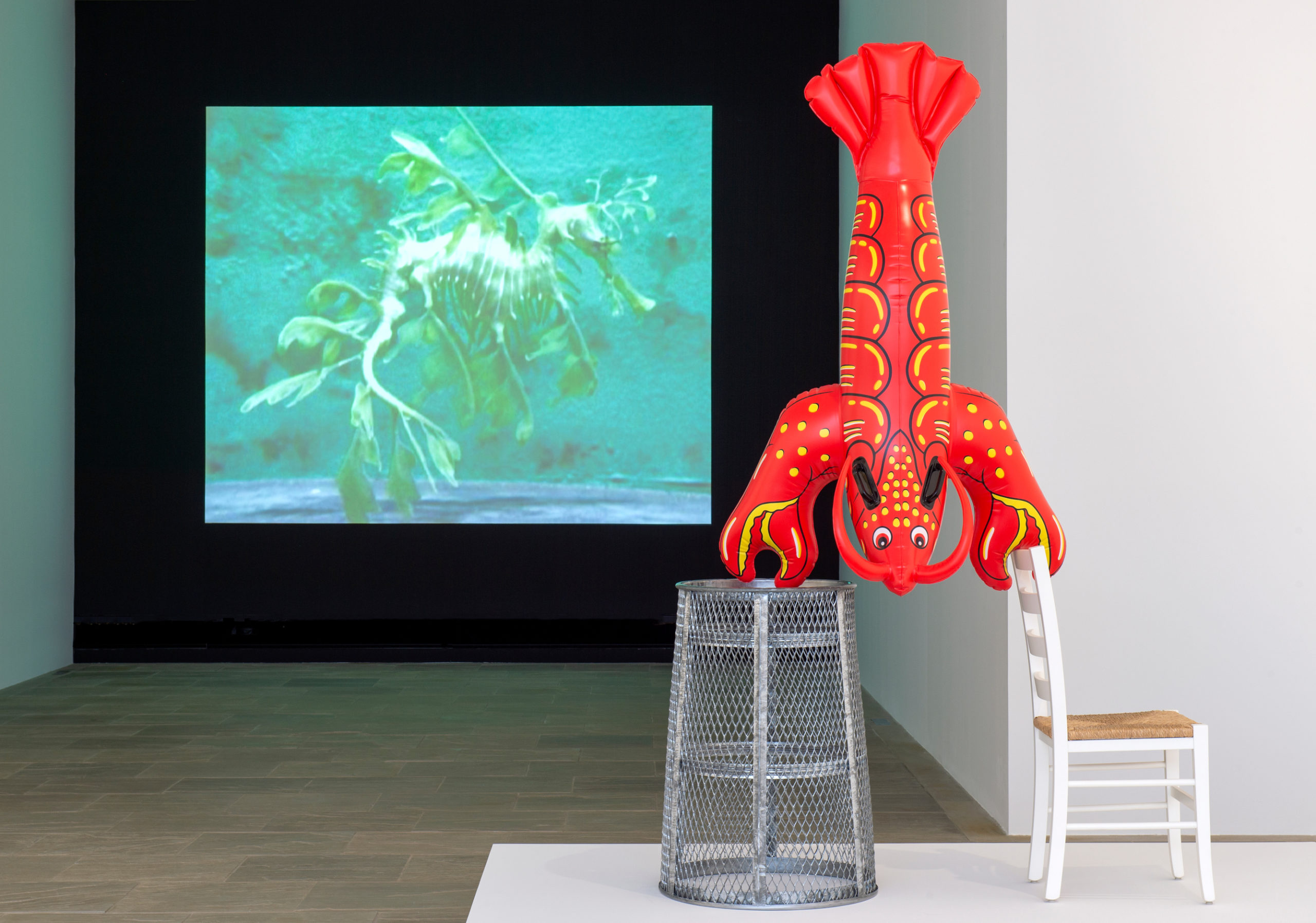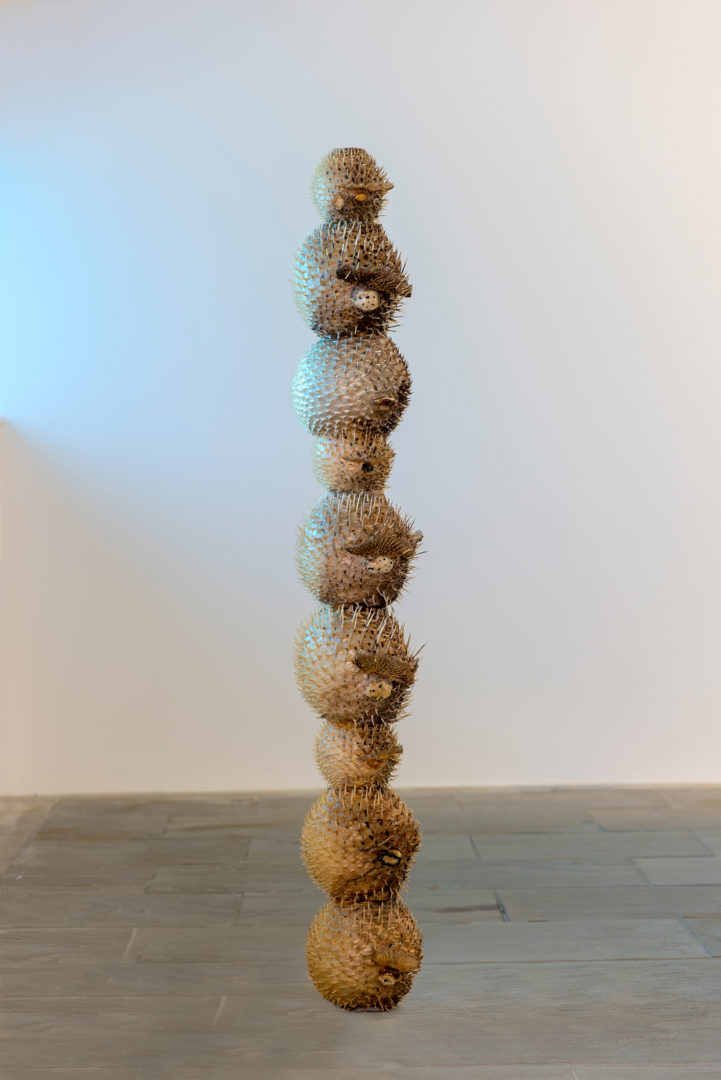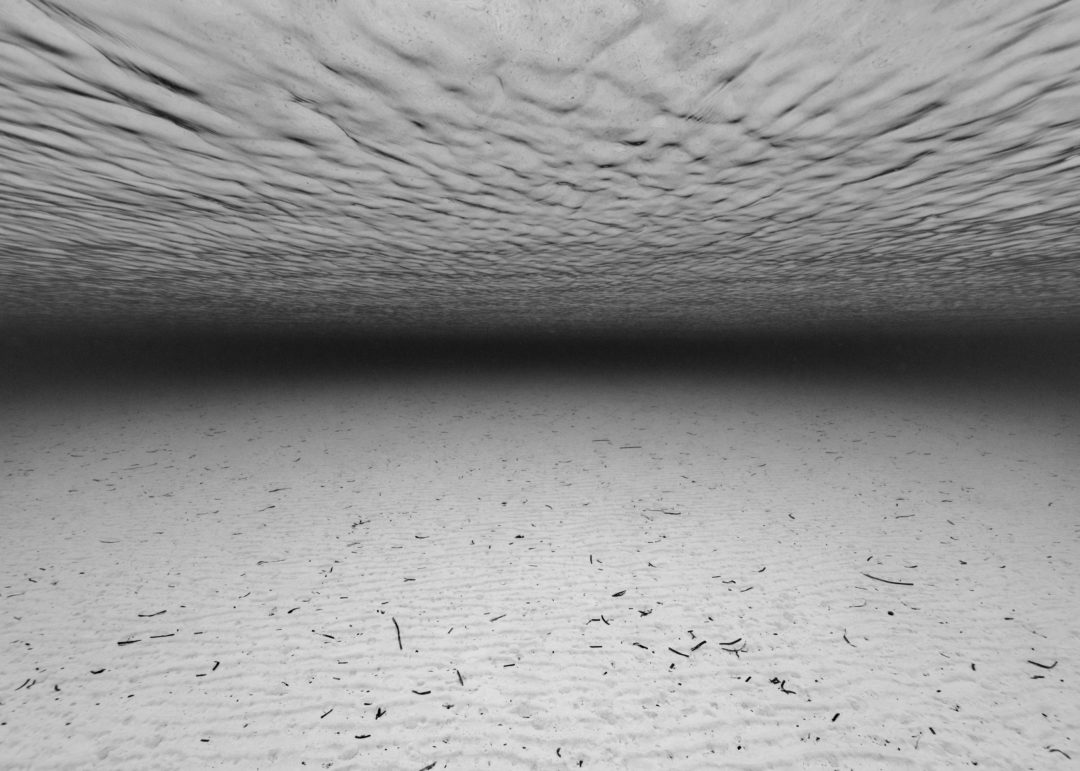Chris Sharp

La Mer imaginaire
Villa Carmignac, Porquerolles, 20.05-17.10.2021
With “The Imaginary Sea”, Chris Sharp offers us a very eclectic vision of the imaginary dimension associated with the sea, playing on the differing accepted meanings of “imaginary”, including those which refer to the imagination proper, or its chimerical aspect. Making the most of the location of the Villa Carmignac in the heart of the island of Porquerolles—a Mediterranean gem lying off the Giens peninsula–, with works already present inside a space which immediately calls an aquarium to mind, the American curator, who is thoroughly acquainted with the European scene and its history, is developing a theme which seemed made for the place. The exhibition alternates between “serious” and “lighter” works, historical works and the output of young artists. If we sense in the background an anxiety about the future of an ocean threatened from all directions by human feverishness, “The Imaginary Sea” does not wallow in a melancholy to which it would nevertheless have been easy to succumb. Quite to the contrary, the exhibition does not lack wit, readily arraying, as it does, various playful works, which avoid the usual clichés connected with the sea. Works which also force us to get closer still to a nature which it is more and more urgent to stop looking at from the full loftiness of our immodesty, to consider it rather as sharing the same fate.

How did the principle behind this exhibition come about? Had you already worked on these themes of the sea and the imagination, or is it to do with a hunch, on the part of the people commissioning the show, that this subject would inspire you?
The idea for this show comes from the space itself, and from a desire I’ve had for a long time to put on an exhibition on the theme of natural history, with all its challenges connected with the current situation and issues to do with the general public. When I discovered the space at the foundation with Bruce Nauman’s wonderful in situ works—a floating fountain with bronze fish—and Miquel Barceló’s large panoramic submarine painting, as well the ceiling of water (without mentioning the fact that the Villa is located on an island), I immediately realized that it was the ideal setting for such a show. The Villa was already half like an aquarium; you just had to fill the other half with sea creatures.
I like the way you say “just”: isn’t that a slightly modest qualification for a task—a curator’s task—that represents a sum of knowledge and affinities, and which involves making choices, connections and associations which are all quite complex in order to lend meaning and form for an exhibition? As it happens, it would seem that this project dates back to a very old encounter, on the one hand: a meeting with one of the characters in a Nabokov novel,1 and, on the other, the desire to find answers to certain questions related to animals—then left unresolved–, their closeness, what they inspire in us, and what they say about our humanity?
It is in fact a little modest, and it’s even a joke, describing the curator’s work as if it were a magic trick. You’ve described it well. I would simply add that, ideally, artists and the exhibition create the curator as much as the curator creates the show. For me, this exhibition would have been inconceivable without having known the work of Jochen Lempert, Michael E. Smith, Shimabuku, and Lin May Saeed, among others; in some cases, those meetings go back more than ten years. They lie at the root of the lines of thought we find in the making of “The Imaginary Sea”. It is through them, for example, that I learnt that questioning our dominant, violent and narcissistic relations with the animal kingdom is of vital urgency. It is also from that thinking that I realized that the selfish supposition of our superiority over the animal kingdom is merely the proof of our inferiority, and that this is something almost infinitely sad which, in the end of the day, deserves a sort of compassion towards ourselves (this largely represents the incomparable pathos of Jochen Lempert’s work). At the same time, it is clear that the formal beauty of many works in the exhibition, like those of Matisse, Jean Painlevé, Paul Klee and Gabriel Orozco, would not exist without a real admiration for submarine life.

This rather incredible, historical and geographical eclecticism contrasts with a lot of shows we’re accustomed to seeing. Do you attribute this to your twofold cultural membership, European and American (North and South)—so transatlantic!—which means that you have an equivalent knowledge of these two scenes? Is this an advantage or, rather, an added difficulty when you have to choose from such a vast array of references?
Thanks. I’ve been extremely lucky for having lived and worked in different cities and, like all curators, I’m always trying to enlarge my knowledge of art. It goes without saying that the exhibition could have included more artists from Asia, and so on, but the issues are rooted in the West, Descartes and the Enlightenment, so it remains essentially an exhibition of the West—even if submarine life is under threat all over the world.
The concept of solastalgia lies at the heart of your exhibition project, it consists in a distress caused by the anticipation of an ecological disaster in the offing; for a lot of people, this disaster is already here. You just have to be aware of the drop in the bee population or the ever rarer fish resources, already brought up in the 1960s by a precursor like Anita Conti.2 The sea has long been regarded an inexhaustible reservoir of riches designed to feed humanity. This, incidentally, is part of another imagination which goes back to the dawn of time, an imagination involving the consideration of nature as an asset that is always available: we can sense that this imagination is in the process of tipping over into its opposite, that it is absolutely vital to protect this asset if we want to go on living on an inhabitable planet. Do you think that art can have any kind of effect in this necessary upset, if only by working on this particular imagination?
Good question. In most instances, I have my doubts about art’s capacity to give rise to real political changes, but in this particular case, I think that the process starts, precisely, with the imagination. The possibility of conceiving of another perception of the animal/human relation, or else nature/culture is already a major step towards a new way of getting along with the natural world—after which comes language. For example, the idea of anthropocentrism which the West is so keen on—and which, incidentally, enables us to see the sea as an “inexhaustible reservoir of riches designed to feed humanity”—seems more and more indefensible. The emergence of a new paradigm introduced by the Anthropocene notion (even if it is not 100% true) was a great shock, I think, for a lot of people. It’s hard to go back. I hate the ideas of exploiting art for any kind of purpose, above all educational, but it is undeniable that much of the beauty of art consists in its capacity to create new possibilities when it comes to seeing, understanding (or misunderstanding) and experimenting with the world.
At the same time, the imagination you are referring to is a relatively calm and “neutral” imagination… We might have expected that this imagination of the sea be seen in its more problematic aspect: the one that turns it into a theatre of perpetual struggles, (sea) battles, Homer to Stevenson, territorial challenges, the violence of forced displacements and the disappearance of migrants—not only that of marine creatures. Why not tackle this particular part of the marine imagination, even indirectly—which it is hard to avoid in 2021?
That would have been a different show, in fact. “The Imaginary Sea” is intended as a plunge into and a stroll under the sea, as well as in the imagination. What is involved is not what goes on on the surface—even if these particular questions are very important, like the issue of immigration—but rather inside. What is more, I think that the question of its interior, its content, is much more pressing than everything happening above the sea. People are invariably a bit surprised when I talk about artists like Jochen Lempert and Lin May Saeed as political artists—given that what is involved is an animal/human relation in their work—but I think that these artists are much more relevant than someone like, for example, Ai Weiwei. Whereas this latter loves focusing on the current situation, Lempert, Lin May and Gilles Aillaud are involved in something much more constant, fundamental and even primordial, with consequences which affect us all.

Is this why Nicolas Floc’h is also present in the Imaginary Sea, producing at the Fort Saint Agathe an exhibition within the exhibition, in the guise of making the case for safeguarding the coastline: a photographic exploration of the sea bed which sidesteps the usual tourist-cum-spectacular treatment, and favours a more realistic and slightly worrying vision of the state of marine flora…?
Precisely, that is indeed why. With this exhibition I’ve tried to offer a somewhat prismatic perspective on the subject of the sea. I wanted there to be difficult moments, as in Nicolas’ work, as well as poetic and joyful times, sometimes in the same work, like for example in the works of Cosima von Bonin and Micha Laury—the one seemingly playful, the other spectacular, but both containing a very critical aspect.
Talking of Micha Laury, the extraordinary chromatic variety of his jellyfish gets us thinking that he has invented a thoroughly imaginary colour spectrum for them, when all he’s done is draw inspiration from reality. If atmospheric temperatures carry on along their rising graph, this animal, with its altogether surprising adaptation capacities, risks becoming the majority population of the oceans, adapting perfectly to climatic shifts and the invasion of plastic, which it uses with great relish, while mammals, seabirds and fish all suffer the lethal effects of plastic. Species disappearing is also an imagination that shrinks… In the future, should we invent new forms on a massive scale, the way the works of Gabriel Orozco, which you are showing, do, at the risk of colonizing and anthropizing the imagination of the sea a little bit more, still?
I don’t know. It’s funny, Gabriel Orozco’s stance in this show is in the end not very far removed from that of Paul Klee (Orozco is a great formalist)—even if the two positions are reversed: Klee uses nature to head towards abstraction, while Orozco uses abstraction to head towards nature, or the natural. Whatever the case, I think it’s impossible to escape from anthropomorphism—but perhaps it’s possible to escape from anthropocentrism, on the other hand. The proof of this may be found in the existence of so many indigenous cultures which maintained a much more reciprocal and respectful relationship with the natural world. This solution can be taken as a step backwards, but I think it’s become a simple question of how to survive.

It’s difficult to sidestep the objectivization and spectacularization of the animal… In her essay, Filipa Ramos3 reminds us what order of distancing the historical arrangement of the museum of natural history—and then of the art museum—complies with: an argument which establishes and imposes a pyramidal way of thinking, just as it essentializes a subject-subject, nature-culture contrast, whose cultural footprint we are still adopting (and undergoing). Although she recognizes that contemporary art is to a great extent re-using these arrangements, she is still optimistic about art’s capacity—associated with its specific features—to deconstruct these contrasts from within. To what degree do you think you have sidestepped this historical organization of the exhibition with “The Imaginary Sea”?
Yes, it’s almost a vicious circle. Although the exhibition model is quite classic, I’ve tried to make visitors aware of the system in two ways: the first, through a quasi-juxtaposition at the start of Gilles Aillaud’s picture, in which we are confronted by an image of rather sad-looking fish looking at us from a half-full and neglected aquarium. This picture is placed beside a photo by Jochen Lempert, showing a father and his baby, looking at fish through the glass side of an aquarium. We are being looked at by what we are looking at. There is nothing natural in this exchange, and I think, or at least I hope, that once you realize all this, it becomes impossible not to acknowledge the basic weirdness of the situation. The second way of pointing out the system to the visitor is that, unlike a classic aquarium, there are no glass sides, and not even partitions in the exhibition venue: everything is open and fluid (perforce—because it’s not a real aquarium—but all the same I wanted to give the impression of wandering about under the water). Symbolically speaking, we are in the sea, with animals.
- Chris Sharp, introduction to the catalogue of “The Imaginary Sea”, p.10, Editions Jean Boîte, 2021.
- In most of the books she has published, Anita Conti, one of the first women to have embarked on a fishing boat on the high seas in the 1950s, already emphasizes the depletion of shoals of cod in areas close to Europe, and the aberration of a fishing method focusing on a single species, leaving behind the other fish which fishermen toss back into the sea like so much ordinary waste (see in particular the sublime tale of her time spent on the trawler-cum-salter spreader Bois-Rosé, Racleurs d’Océan, Petite Bibliothèque Payot, 2017).
- Chris Sharp, introduction to the catalogue of “The Imaginary Sea”, p.10, Editions Jean Boîte, 2021.
- In most of the books she has published, Anita Conti, one of the first women to have embarked on a fishing boat on the high seas in the 1950s, already emphasizes the depletion of shoals of cod in areas close to Europe, and the aberration of a fishing method focusing on a single species, leaving behind the other fish which fishermen toss back into the sea like so much ordinary waste (see in particular the sublime tale of her time spent on the trawler-cum-salter spreader Bois-Rosé, Racleurs d’Océan, Petite Bibliothèque Payot, 2017).
- Chris Sharp, introduction to the catalogue of “The Imaginary Sea”, p.10, Editions Jean Boîte, 2021.
- In most of the books she has published, Anita Conti, one of the first women to have embarked on a fishing boat on the high seas in the 1950s, already emphasizes the depletion of shoals of cod in areas close to Europe, and the aberration of a fishing method focusing on a single species, leaving behind the other fish which fishermen toss back into the sea like so much ordinary waste (see in particular the sublime tale of her time spent on the trawler-cum-salter spreader Bois-Rosé, Racleurs d’Océan, Petite Bibliothèque Payot, 2017).
- Filipa Ramos, L’éléphant dans la pièce, p.54.
Image on top : Vue de l’exposition / Exhibition view of « La Mer imaginaire », Fondation Carmignac (Porquerolles). Photo : Marc Domage. (à gauche / on the left) Shimabuku, Les feuilles nagent, 2011. Courtesy de l’artiste / the artist & Air de Paris, Romainville. (à droite / on the right)Jeff Koons, Acrobat, 2003-2009. © Jeff Koons – Collection Carmignac
- From the issue: 97
- Share: ,
- By the same author: Modern Love at musée d'art contemporain d'Athènes, Interview Anne Bonnin,
Related articles
Don’t Take It Too Seriously
by Patrice Joly
Déborah Bron & Camille Sevez
by Gabriela Anco
Sanam Khatibi
by Gabriela Anco

